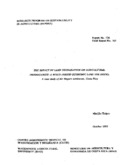| dc.contributor.author | Kuiper, M. | |
| dc.contributor.other | CATIE - Centro Agronómico Tropical de Investigación y Enseñanza | |
| dc.date.accessioned | 2014-10-18T03:37:07Z | |
| dc.date.available | 2014-10-18T03:37:07Z | |
| dc.date.issued | 1997 | es_ES |
| dc.identifier | 354609 | es_ES |
| dc.identifier.uri | https://repositorio.catie.ac.cr/handle/11554/4226 | |
| dc.description | 6 fig. 30 tab. 56 ref. También como: Field Report - Atlantic Zone Programme (CATIE) no. 165 | es_ES |
| dc.description.abstract | Current land use practices will have to be sustainable in order to guarantee a sufficient level of agricultural production for future generations. In this study a sub-regional multi-period linear optimization model of agricultural land use is developed in which land use decisions take their impact on future productivity into account. Given the time-lags associated with land degradation processes a long time horizon is required. However, the incorporation of the dynamics of investments in perennial crops simultaneously demands time periods of just a few years. To address these opposite requirements four periods of varying length are distinguished within a total planning period of 20 years. The first two periods comprise only one and two years, respectively, to capture the net investment period at the start of perennial cropping cycles. The last two periods cover six and eleven years to account for the long term effects of land degradation. In the model land use practices affect production in following periods through inducing changes in soil fertility, which on their turn affect the production levels, as well as by a requirement to maintain productive perennials form previous periods. These relations between periods combined with an objective function maximizing economic surplus over all four periods forces land use decisions to incorporate their effect on future production possibilities. Three versions of the model have been applied to the Neguev settlement, Costa Rica in order to assess the effect of land degradation on land use patterns as well as the effect of using an average slope instead of different slope classes. Inclusion of the effects of land degradation in the analysis results in almost thirty percent of the agricultural land being left fallow in the first three periods to avoid productivity losses in the last period. These fields are cultivated in case the effects of land degradation are excluded from the analysis. Use of an average slope instead of slope-classes resulted in an underestimation of the amount of erosion together with the use of degradation prone soils in the early periods of the planning horizon. A comparison of the modeling results to the actual land use pattern indicates that several extensions will be needed before the model can be used to assess the long term effect of agricultural policies on the sustainability of agriculture. | es_ES |
| dc.language.iso | en | es_ES |
| dc.publisher | CATIE, Turrialba (Costa Rica). Agricultural University Wageningen, Wageningen (Países Bajos). Ministerio de Agricultura y Ganadería, San José (Costa Rica) | es_ES |
| dc.relation.ispartof | Report - Atlantic Zone Programme (CATIE-WAU-MAG); number 124 | es_ES |
| dc.rights | info:eu-repo/semantics/openAccess | es_ES |
| dc.subject | DEGRADACIÓN DEL SUELO | es_ES |
| dc.subject | UTILIZACIÓN DE LA TIERRA | es_ES |
| dc.subject | PRODUCTIVIDAD DE LA TIERRA | es_ES |
| dc.subject | METODOS DE OPTIMIZACIÓN | es_ES |
| dc.subject | TERRENO EN DECLIVE | es_ES |
| dc.subject | SOSTENIBILIDAD | es_ES |
| dc.subject | CARACTERÍSTICAS DEL SITIO | es_ES |
| dc.subject | COSTA RICA | es_ES |
| dc.subject | EROSIÓN | es_ES |
| dc.subject.other | Sede Central | |
| dc.title | The impact of land degradation on agricultural productivity a multi-period economic land use model; a case study of the Neguev settlement, Costa Rica | es_ES |
| dc.type | Reporte | es_ES |


